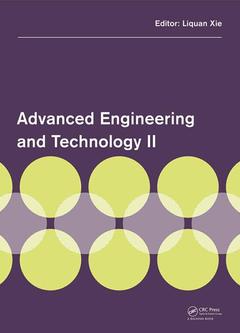Preface; Numerical simulation of the impact of the seawall project in Xiaohao on 2D tidal current; Accuracy assessment of the global ocean tide models based on tide stations; The damaging effect of carbonation process on frost resistant concrete after freeze/thaw cycles; Synthesis, characterization and photocatalytic studies of Carbon, Cobalt co-doped mesoporous nano titania with anatase crystalline structure; The coregistering and fusing for multibeam echosounder sonar and side scan sonar data; Geoecological factors of health risk for population of Solnechny mining settlement, Khabarovskiy Krai; Urban heat island mitigation and urban energy equilibrium through urban forest development; Effect of external electric field on electrostatic enhancement bag filter for removal of PM2.5; Simulation of turbulence effect of solid on mass transfer in a bio-fluidized bed reactor; Optimized operation model of reservoirs in heavy sediment-laden rivers based on the statistical theory; Application and economic profit of a new upward-pushing flow integrated oxidation ditch; Composite element model for jointed rock masses reinforced by shotcrete lining and bolt; Configuration and construction technology of shrinkage-compensating concrete; Effects of fatigue loading and environmental erosion on the damage of reinforced concrete bridges; Study of effects of ionic strength and pH on PAHs removal by nanofiltration; Grouting method of the dam foundation and the field grouting test construction; Experimental verification of a new ecological fishway; Experimental study on internal solitary wave induced flow field; Numerical simulation of the tunnel’s water inflow in the interlayer porous karst; Developing characteristics of quick cutting-induced pore water pressure in the seabed; Effect of water-fertilizer coupling on yield, quality and soil nutrient content of tomato in greenhouse; The study on compensation mechanism of ladder pricing with logistic applied into demand in households; Research of the space-time congestion model of traffic flow in port waters; Comprehensive evaluation of water resources utilization efficiency and its difference analysis in the Yellow River Basin based on entropy model; Effect of arsenic concentration in irrigation water on soil and rice quality; The dynamic evaluation of water resources security of Guangxi province in China based on the modified water resources ecological footprint model; Research on numerical simulation of three dimensional temperature field in shallow lakes; Pollution level and health risk of heavy metals in the water of the Taizihe River Basin, China; Influence of junction angle and flux ratio on three-dimensional flow structure in cross-section of confluence at confluent meander bends; Mechanism research of removing the moisture in sludge bio-drying; Structure decomposition analysis of water consumption in Zhangye City; Phytoplankton community and related environmental factors in a plateau shallow lake; Research of CODMn and TN release rate in Chang Lake, Hubei Province, China; Using the random forest method for classification and regression in hydrology; Numerical simulation of groundwater in the upper of Chaobai river alluvial fan in Beijing; Assessment of trace elements in water of Beijing urban lakes, China; Effect of over-exploitation on underground water quality in the upper part of the Chaobai river Alluvial Fan in Beijing; Impact analysis of vegetation coverage in slope on soil infiltration capacity; A quality-quantity equilibrium model for urban water resources allocation; Comprehensive evaluation of aquatic ecosystem in Daning reservoir; Study on a new monthly decomposition model of contract energy for cascade hydropower stations based on risk preference…/Part Contents





